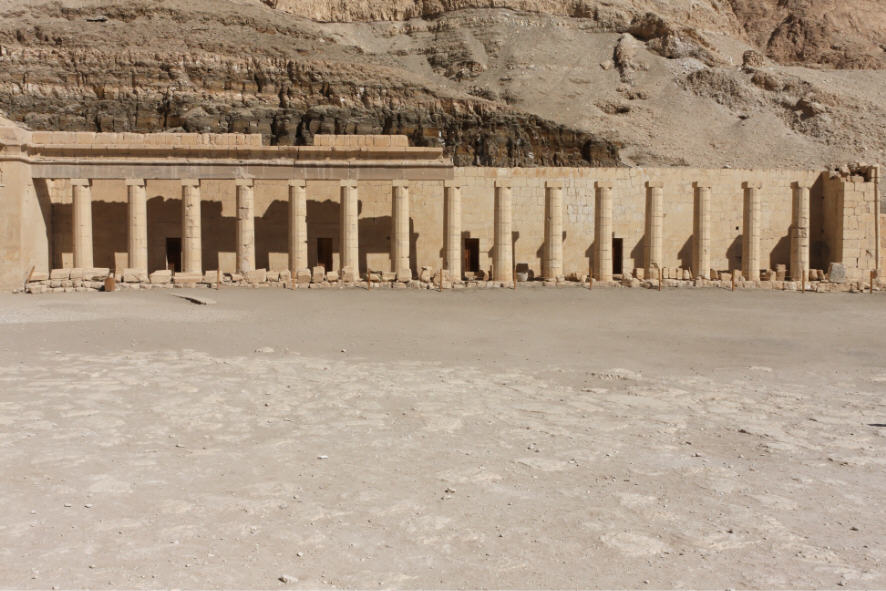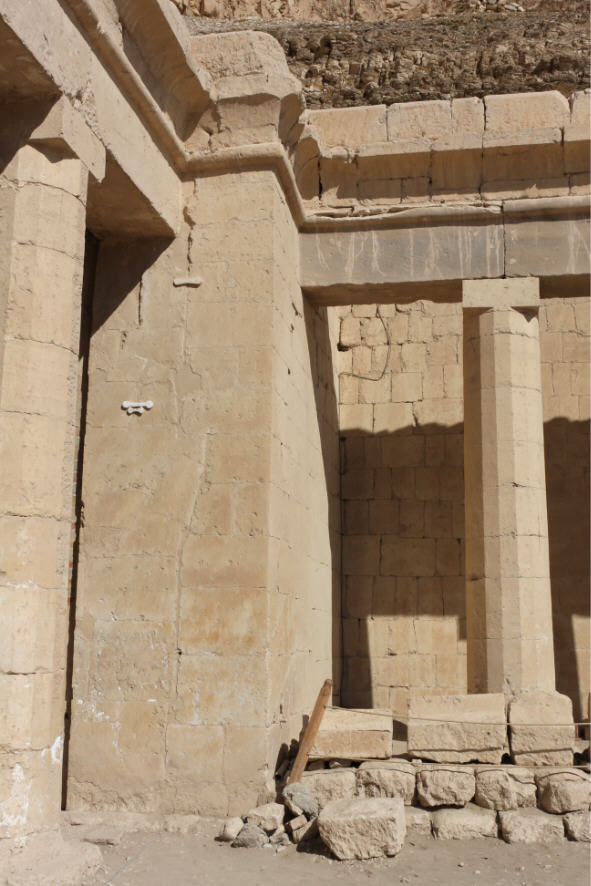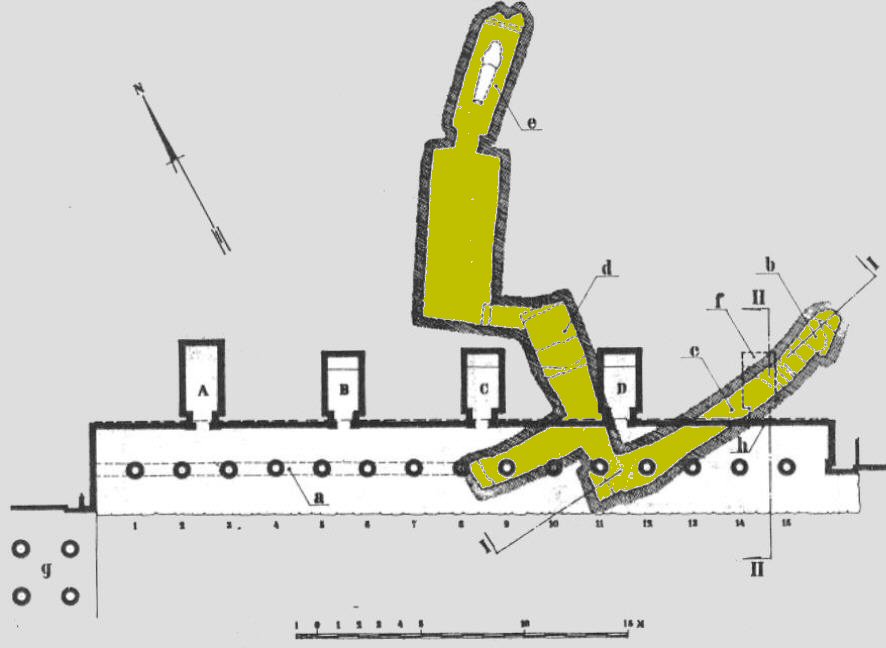|
The northern Portico
of the 2nd Terrace |
update:
29.08.2010
|

|
On its northern side the 2nd terrace of the temple is bordered by an unfinished
portico which is about 37 ms wide and about 5 ms high. In contrast to all other
porticos of the temple this has a colonnade with only one row of columns which is made up of 16 proto-Doric 16 sided columns.
The full height of the freestanding columns is about 4.30 ms on average from the
capital. The intercolumnar spaces measure about 1.5 ms between the capitals (Winlock,
19030; Wysocki,
1984, 1985a). |
| It had been planned to build 5 chapels in the rock behind the
colonnade, however, only four were finished. Their entrances lie in the breast
wall of the portico (see plan below; A D). The westernmost chapel A is somewhat
larger (1.57 x 3.16 ms) than the other three (1.55 x 2.61 ms). All chapels are
raised one step above the Colonnade level (Naville, E., The Temple of Deir el-Bahari, Part
II. London 1894-1908, S. 8). |
|
The chapel A has its entrance between the 2nd and 3rd, the chapel B between the
5th an 6th, the chapel C between the 8th and 9th, and the chapel D between the
11th an 12th column. Between the 15th and 16th column there is a large stone
block set into the wall like a portal-head, suggesting that another chapel was planned there
(Naville, loc. cit.). |
|
All chapels have a vaulted ceiling and the three eastern ones have raised seats
across their northern ends. The interior of the chapels has been left
unfinished, they reveal plain walls without any decoration (Naville, E., The
Temple of Deir el-Bahari, Part II. London 1894-1908, S. 8). For which purpose
these chapels were intended, is not known. |
|
In later times the chapels were obviously used by embalmers as documented by
finds of Naville. |
| The portico was erected on a pavement, which was raised some 0.3 ms above the
2nd terrace. |
| The whole portico, with the exception of the architraves over
the 8 western columns, was erected with limestone. The architraves were worked
from sandstone with a violet hue. |
|
Wysocki pointed out that the construction was of worse quality in comparison
with other sections of the temple. The blocks which were used for the
erection of the wall were smaller, differed in the size, or were more badly
bonded with mortar. The mortar beds were not even and numerous steps give the
impression of irregular layout. |
|
Naville purported that the violet architraves were taken from the nearby temple
of Mentuhotep Nebhepetra and re-used in the northern portico. This was rejected
by Wysocki who pointed to the fact that height and width of the blocks have
other dimensions than the blocks at the temple of Mentuhotep.
|
| The portico was not finished. The western part was nearly
completely finished, however, approximately starting from the
center on the eastern (right) side the architraves over the columns are missing.
The easternmost chapel (f) was not realized, and the whole building is without
any decoration. However, traces of tooled dressing suggest that the stone blocks
were still in preparation for future decoration when the work on the portico was
stopped. |
| After the work at the northern portico was stopped the mass of
the fragments which was piled on the 2nd terrace from the digging out the
chapels was left there until modern times. |

|
At the western corner the abutment of the Vestibule of the
Lower Chapel of Anubis is not connected with the northern portico, i.e. the
northern portico is leaning only against the chapel. The joint between the two
buildings is today to still recognizable today (see photo above). Wysocki assumed
that the northern end of the facade of the Lower Chapel of Anubis had been
decorated. However, this area is currently obscured by the northern portico,
thus it is not possible to verify this assumption. |
|
The northern portico was unquestionably the last larger extension of the temple.
As Wysocki (1984, 1985a) has shown, the northern portico is not connected with the
masonry of the 2nd portico, but only follows the northern side of the lower
chapel of Anubis. That means, the 2nd terrace had probably been (to a large
extent) finished, before with the work on the northern portico was started. |
| On the other hand, the northern portico, as described above,
remained unfinished. In addition, Wysocki interpreted the use of irregular
stones in the retaining wall before the northern cliff as reference to a
beginning "shortage" of material. |
|
Thus the question arises, when was the northern portico built, and why has it
not been finished. |
| In the opinion of Naville (in: Naville, E., The Temple of Deir
el-Bahari, Part II. London 1894-1908, S. 8) the unfinished state of the northern
portico had be considered in connection with the death of the queen. |
|
In 1929 Winlock discovered the partly plundered tomb of Queen Meryet-Amun
(TT358) which was entered by shallow vertical shaft (b) located about 4.5 ms far from north-eastern corner of the
portico (see following drawing). |

| Floor plan of the northern portico and the location of the
tomb TT358
of Meryet-Amun (taken from Wysocki, 1984, modified). |
| b - e |
|
B = entrance shaft to TT358; c = passage, d = well, e = burial chamber |
| g |
|
pillared hall in front of the Lower Chapel of Anubis |
| 1 - 15 |
|
Columns of the colonnade |
|
The entrance passage (c) runs to the eastern corner of the northern portico,
stops under columns 11 and 12, turns north leading to a vertical shaft (d).
Shortly after the bend a smaller passage branches off to the west and ends below
columns 8 an 9. Behind the shaft there is another chamber which leads to the
burial chamber (e). |
| Between 4.5 and 5 m from the entrance the cutting of the roof
of the passage exposed the under side of the foundations of the back wall of the
northern portico. On the left, the passage was cut in to the foundation trench
exposing 25 cm in depth, and the roof the under sides of one or two foundation
block were exposed. However, since the passage descended at about 8 cm per meter
no further blocks were exposed. That none of the foundation stones had fallen
into the passage was explained by Winlock with the fact that the blocks were
tightly wedged together and that the mortar between them was fully hardened
before the passage was dug (Winlock, H.E., The Tomb of the Queen Meryet-Amun at Thebes. New York 1930). |
| Based on these observations Winlock concluded convincingly that
the northern portico was built before the tomb. Otherwise, if the tomb had been
in existence before the foundation trench was quarried out, the cutting down
into the shale probably would have cause a greater part of the passage roof to
collapse and it would not have been possible to put the large blocks of the
foundation across the opening without a supporting wall in the passage.
|
|


